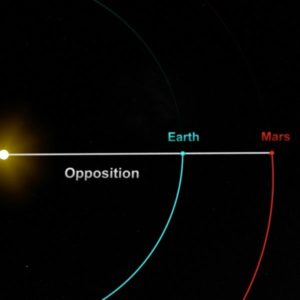
Photo: An artist’s rendition of Mars in proximity to Earth | Getty Images
Mars is reaching full opposition on October 13, 2020, when it will be biggest and brightest in our skies. Mars oppositions occur approximately every 2 years, but this year one special—Mars won’t appear to be this big and bright again for another 15 years.
What is the Opposition of Mars?
Opposition occurs when a planet is on the opposite side of the celestial sphere to the Sun, as observed from Earth. During opposition, the planet in question is at its closest point to Earth in its orbit and in its full phase. This makes the planet appear bigger and brighter in the night sky than usual, creating ideal conditions for observation.

When Mars reaches opposition, Earth is directly between it and the Sun | Kel Elkins/ NASA
What makes this opposition special?
It takes 687 days, for Mars to complete a trip around the Sun—the time it takes for Earth to complete 2 orbits. It is for this reason that Mars and Earth only line up every two years. Because the two planets follow elliptical paths in their orbits, some oppositions occur at closer points than others. This is the case with the opposition occurring this month, and one like it won’t occur again until the year 2035. But don’t worry, you’ll have plenty of time to see the Red Planet at its biggest and brightest. Mars will be one of the brightest objects in the night sky from now until the end of October.
How can I view the Opposition of Mars?
Mars will be shining bright when it rises just after sunset (about 5:55pm local time). That being said, there truly is no bad time to see Mars, as long as you have a clear view of the night sky. After sunset, look to the eastern horizon. You will see a very bright star with a reddish-orange glow—that’s Mars! Mars will get higher in the sky throughout the night, reaching its highest point at 12 midnight local time. It will then move toward the west, where it will set just before sunrise. Mars will be at its very closest and brightest on October 13, and will progressively grow dimmer as it moves away from us in November.
Celebrate Mars Month with us!
We’ll be bringing you special Mars-related content all month long, so be sure to stay connected to our social media channels! We’ll show you live views of the Red Planet at its biggest and brightest during our weekly Interactive Stargazing streams, along with some other planned celestial objects and those suggested by our viewers via Youtube’s chat function. Our next Interactive Stargazing stream will go live on Tuesday, October 13, at 8pm AZ/PT (Oct. 14 at 3am in UTC). Don’t miss out—it’s going to be Mars-nificent!
Some helpful astronomy apps to check out:
The apps described below use Augmented Reality (AR) to help you locate celestial objects using the camera on your smartphone. They may be especially helpful this month if you find yourself having trouble locating Mars in the night sky.
Stellarium: This planetarium software is available for a free download on desktop, and for a small fee as a mobile app. The desktop version offers a lot more control over location, time, and date than the mobile version, and the program will show you a lot more information about any object you select. You can also turn on constellation lines/names, which can help with finding things in the sky. This is what Lowell Educators use to learn about the sky and constellations! Get more information about Stellarium here.
Sky Safari: This professional telescope astronomy software is available in a variety of versions as a mobile app, including a free version. Users can point their phone at the sky and (if its calibrated), and the app will label the objects they are seeing in the sky. This is what Lowell Educators use to control the telescopes at the Giovale Open Deck Observatory! Get more information about Sky Safari here.